Bosch Dishwasher Lave-vaiselle SHX3AR User Guide
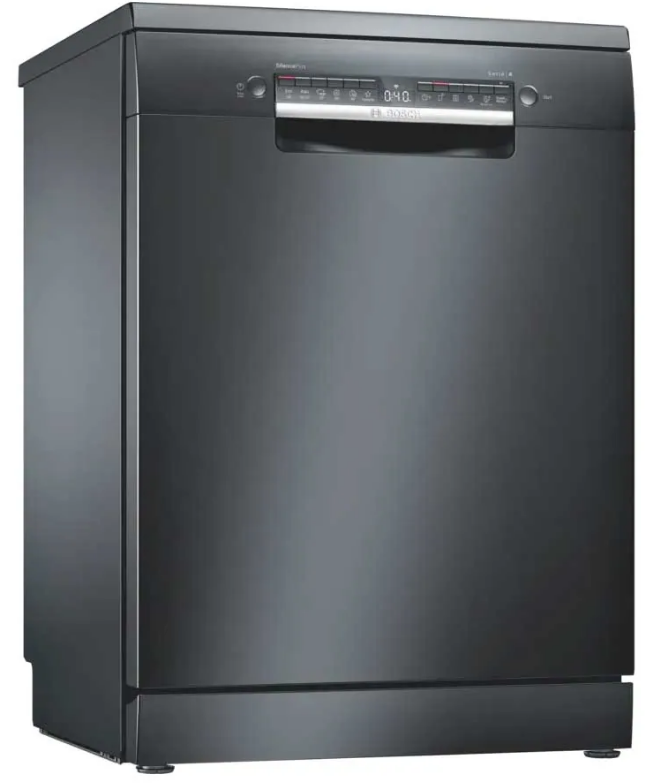
Content
Introducing the Bosch Dishwasher Lave-vaiselle SHX3AR
The Bosch Dishwasher Lave-Giselle SHX3AR is a sleek and efficient appliance designed to provide exceptional cleaning performance for your kitchen needs. With a spacious interior that accommodates up to 16 place settings, it features a flexible 3-rack system for easy loading of various dish sizes. Operating at a quiet 44 dBA, this dishwasher ensures minimal noise during cycles. It includes multiple wash programs, including an eco-friendly option, making it suitable for everyday use.The cost of the Bosch SHX3AR typically ranges around $949.00, reflecting its advanced features and reliable performance.
Specifications
| Connection | |
|---|---|
| Consumption values | |
| Watts (W) | 1,300 W |
| Power cord length (cm) | 110 cm |
| Current (A) | 12 A |
| Length outlet hose (cm) | 200 cm |
| Plug type | fixed connection |
| Water consumption, programme 5 (l) | 4.1 |
| Maximum temperature for water intake (°C) | 60 °C |
| Water consumption, programme 3 (l) | 8.8-20.8 |
| Water consumption, programme 4 (l) | 14.3 |
| Water consumption, programme 1 (l) | 18.6-24.2 |
| Water consumption, programme 2 (l) | 13.1-24.5 |
Getting Started
Appliance overview
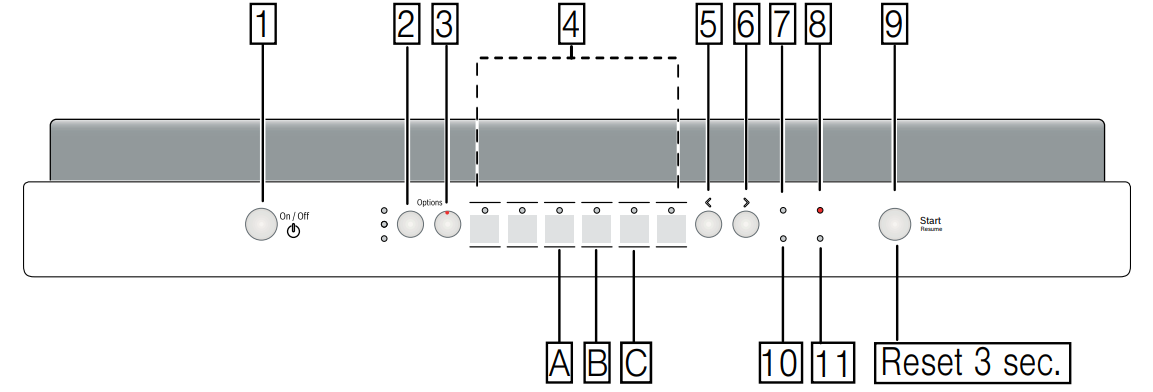
The dotted lines show optional features which may or may not be included with your dishwasher.
The numbers stated below refer to the overview images on the previous page of this manual.
Operating panel
- On/Off button
- Wash cycles
- Digital display
- Delay start button
- Wash cycle options
- Start button
Dishwasher interior components
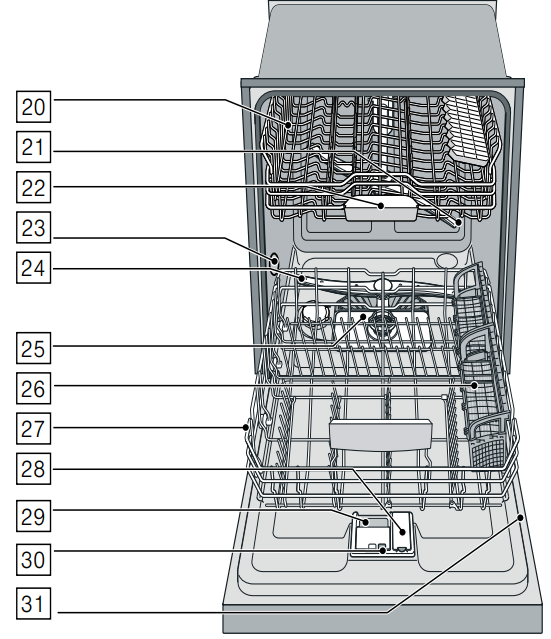
- 20. Interior light
- 21. Third rack
- 22. Upper rack
- 23. Upper spray arm
- 24. Detergent tab tray
- 25. Vent hole
- 26. Lower spray arm
- 27. Dispenser for special salt
- 28. Filters
- 29. Silverware basket
- 30. Lower rack
- 31. Rinse aid dispenser
- 32. Detergent dispenser
- 33. Lock for detergent dispenser
- 34. Rating plate
Optional feature which may or may not be included with your dishwasher.
Display indicators
- Active Lights up when wash cycle is running
- Clean Lights up when dishes are clean
- Sanitized Lights up when sanitation requirements are met
Menu overview
The dishwasher has been preset with certain settings for your convenience. You can change these factory settings.
Use the function keys #, +, and 3 to change the settings.
Setting Factory setting Description | ||
rRinse aid r:00 - r:06 | r:05 | Amount of rinse aid affects drying. |
d Intensive drying d:00 - d:01 | d:00 / Off | Improved drying for glasses and plasticware. |
˜ Auto power off P:00 - P:02 | P:00 | Dishwasher switches offautomatically after wash cycle is complete. |
Rinse Aid
To achieve proper drying, always use a liquid rinse aid, even if your detergent contains a rinse aid or drying additive.
Note: The dishwasher indicates low rinse aid by turning on the Rinse Aid indicator. If this indicator lights up, you need to refill the rinse aid dispenser 31 by following the directions below.
Adding rinse aid
NOTICE
To avoid oversudsing or clogging, do not overfill the rinse aid dispenser 31. Wipe up any spills with a damp cloth.
Open the rinse aid dispenser 31 by pressing on the latch of the lid and pull it open.

Add liquid rinse aid to the dispenser 31 until it is full. Do not overfill. Avoid spilling into air vent hole.
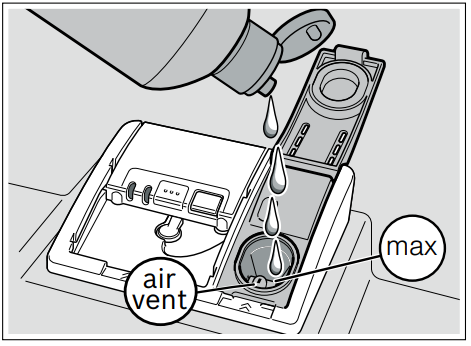
- Close the lid. Lid must be fully closed until it clicks in order to seal.
- Wipe up any excess rinse aid that may have puddled when the dispenser reservoir is full.
The indicator light will go out a few moments after the dishwasher door is shut.
Tip: For easier pouring, remove lid from the rinse aid bottle.
NOTICE
Do not fill the rinse aid dispenser 31 with detergent. Doing so will damage the dishwasher.
Setting the amount of rinse aid used
The amount of rinse aid dispensed can be set from r:00 to r:06. The factory setting is r:05. You should only change the setting if streaks remain on the dishes (lower the amount), or if dishes are not getting dry enough (increase the amount).
| r:00 | dispenser is OFF |
| r:01 | lowest setting |
| r:02 | low setting |
| r:03 | medium setting |
| r:04 | medium/high setting |
| r:05 | high setting |
| r:06 | highest setting |
- Press the On/Off button 1.
- Hold down the function key A and press the Start button 6 until the display 3 indicates H:0x or d:ox (x can be any number). Release both buttons.
- Press the function key A until display 3 shows r:05.
- Press the function key C to select the desired setting.
- Press the Start button 6 to save the setting.
Turning off the rinse aid indicator
Proceed as described in the section “Setting the amount of rinse aid used” and set the value to r:00. The rinse aid indicator is now turned off.
NOTICE
Using no rinse aid or setting the dispenser to r:00 may result in longer cycle times consuming more energy and water. The higher temperatures and longer cycle times can damage fine china or glassware.
Description
The Bosch SHX3AR dishwasher is designed with both functionality and aesthetics in mind. Its sleek and integrated design allows it to blend seamlessly into any kitchen decor. The interior features a stainless steel tub, which enhances durability and resistance to rust. The dishwasher also includes a third rack, providing extra storage space for utensils, glasses, and small items. The user interface is intuitive and easy to navigate, making it simple to select the right wash cycle for your needs.
The dishwasher’s advanced sensors and precision temperature control ensure that dishes are cleaned thoroughly while minimizing energy consumption. Additionally, the CrystalDry technology uses zeolite minerals to absorb moisture and release heat, resulting in superior drying performance compared to traditional drying methods.
Loading the Dishwasher
Dishware material
Note: Before using your dishwasher for the first time, check the information in this section. Some items are not dishwasher-safe and should be hand washed; others require special loading.
Recommended
| Aluminum | Colored anodized aluminum may fade over time. Minerals in your water may cause the aluminum to darken or spot. This can usually be removed with a soap-filled steel wool pad. |
| China, Crystal, Stoneware | Some hand-painted utensils may discolor, fade or spot. Hand wash these utensils. Position fragile glassware so that it will not topple over or come in contact with other utensils during the wash cycle. |
| Glass | Make sure to use dishwasher-safe glass. Milk glass may discolor or become yellow. |
| Non-stick Coatings | Apply a light coating of vegetable oil to non-stick surfaces after drying. |
| Plastics | Make sure the plasticware is dishwasher-safe. |
| Stainless Steel, Sterling Silver and Silver Plates | Load these so they do not come in contact with other metals, stainless steel dishwasher tub walls or the inner door. |
Not Recommended
| Acrylic | Crazing or small cracks throughout the acrylic, may occur. |
| Adhesive- Joined Pieces | Adhesives that join materials such as plastic, wood, bone, steel, copper, tin, etc. may loosen. |
| Bone-Handled Utensils | Handles may separate. |
| Iron | Iron will rust. Hand wash and dry immediately. |
| Non-Dishware Items | Your dishwasher is intended for use in cleaning ONLY standard household dishware and kitchenware. |
| Pewter, Brass, Bronze | These items will tarnish. Hand wash and dry immediately. |
| Tin | Tin will stain. Hand wash and dry immediately. |
| Wood | Wooden bowls, wooden utensils and utensils with wooden handles can crack, warp and lose their finish. |
Loading the racks
For best dishwashing results, observe the following when loading the dishwasher:
- Do not pre-wash items with loosely attached food soil.
- Remove all food particles, bones, toothpicks and excessive grease.
- Pre-treat items having burned-on, baked-on or starchy soils.
- Load dishes in the dishwasher racks so the insides of bowls, pots and pans are facing the spray arms.
- Avoid nesting and contact points between dishes.
- Separate items of dissimilar metals. Use care to not block movement of the spray arms.
- Only wash household dishware and kitchenware rated as dishwasher-safe.
Refer to the Dishware Materials section for more information about dishware suitability.
NOTICE
To avoid dishwasher damage, do not load the dishwasher with paper products, plastic bags, packing materials or anything other than normal, dishwasher safe dishware and kitchenware.
Loading the upper rack
Ensure items do not protrude through the bottom of the racks and block the spray arms.
Note: When pushing the upper rack 12 into the dishwasher, push it until it stops against the back of the tub so the upper rack spray arm 23 connects to the water supply at the back of the tub. Do not push racks in using the door.
Loading the lower rack
Place large items in the lower rack 30 Load pots, pans, and bowls upside down. Do not block the vent hole 25 with tall baking sheets. Load these items on the right side of the dishwasher.
Loading patterns for the lower rack
12 place setting suggested loading pattern
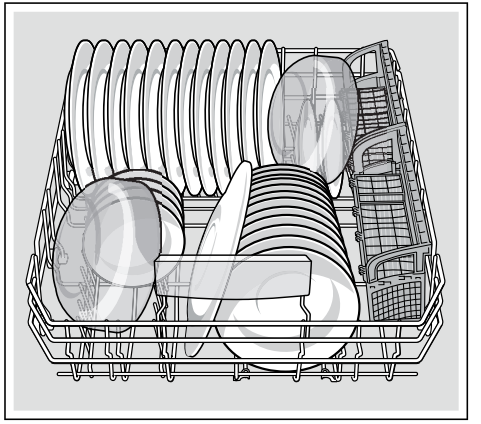
Alternate loading pattern
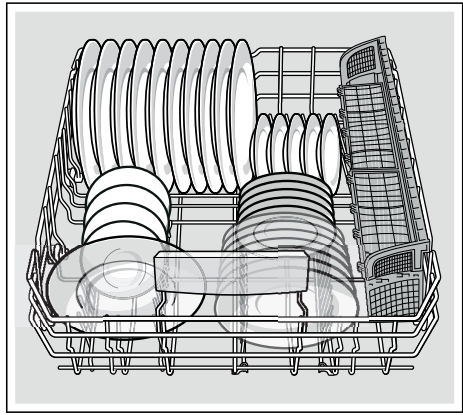
Alternate loading pattern with pots and pans
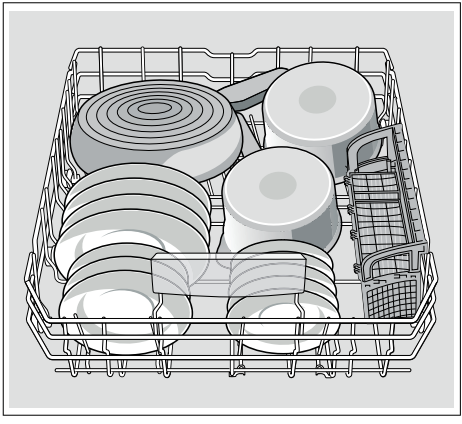
For best results, load large items face down in the lower rack.
Loading patterns for upper rack
12 place setting suggested loading pattern, with third rack cutlery drawer
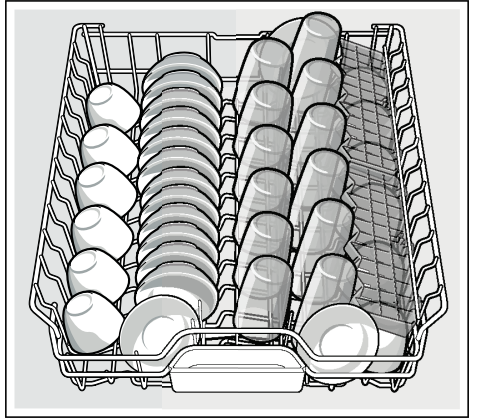
Alternate loading pattern
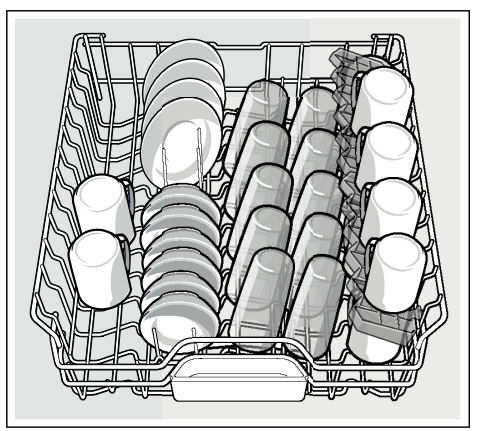
Alternate loading pattern with stemware
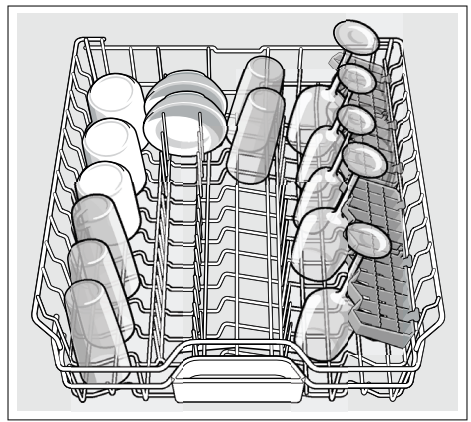
Use supports to load stemware glasses in the upper rack.
Setup Guide
Setting up the Bosch SHX3AR dishwasher involves several steps to ensure proper installation and operation:
- Unpack the dishwasher carefully and inspect for any damage during shipping.
- Follow the manufacturer's instructions for electrical connections and water supply hookups.
- Level the dishwasher to prevent any imbalance during operation.
- Install the mounting hardware to secure the dishwasher in place.
- Run a test cycle to ensure all connections are secure and functioning correctly.
Refer to the user manual for detailed instructions on configuring wash cycles, using detergent, and maintaining the appliance.
Care and Maintenance
A regular inspection and maintenance of your machine will help to prevent faults. This saves time and prevents future problems.
Cleaning the dishwasher
- Regularly wipe the front of the appliance with a damp cloth - water and a small amount of liquid soap is adequate.
- For black stainless steel and anti-fingerprint surfaces, use a soft, dry towel. For stubborn dirt, use warm water diluted with a non-abrasive, mild cleansing soap. Never use stainless steel polish.
- For stainless steel appliances (excluding black stainless and anti-fingerprint), use a stainless steel polish to seal and protect the surface.
- Clean the outer edges of the inside door panel regularly to remove debris that may collect from normal loading. If spots begin to appear on the stainless steel, make sure the rinse aid dispenser is full and functioning properly.
- Clean the door seal regularly with a damp cloth to remove food particles that may collect from normal loading and cause odor. A soiled door seal may not seal properly.
NOTICE
- Never use a steam cleaner to clean your dishwasher. The manufacturer is not liable for any resulting damage.
- Do not use sponges as they could scratch the surfaces.
- Do not use bleach-based wipes as they could damage the surface or printing.
- Never use stainless steel polish on a black stainless finish or anti-fingerprint surfaces.
WARNING
RISK OF EXPLOSION!
- When cleaning your dishwasher with any cleaning agent, remove all cookware, utensils or any foreign material from inside. Some cleaning agents are highly acidic and/or caustic alkaline, which can cause hydrogen gas to form if aluminum material is also inside the dishwasher tub. Hydrogen gas is explosive.
WARNING
- Use caution when removing parts for cleaning as some debris may be sharp.
Filters
The Bosch filter system 1b is designed to prevent the need to pre-rinse normally attached food soils from your dishes. Simply scrape leftover food soils off of dishware before loading. This process will conserve time, water and the energy required to heat your household water supply.
Your dishwasher filter system is designed to filter 100% of the water entering the spray arms to provide a continuous supply of clean water to remove food soils from your dishware.
Filter components
The filter system 1b consists of three parts.

- A Large Object Trap
Prevents objects that should not be placed in your dishwasher from damaging the dishwasher pump system or clogging your household drain. - B Flat Fine Filter
Prevents food particles from entering the wash chamber and directs particles toward the micro filter. - C Micro Filter
Directs the smallest of particles to the household plumbing drain.
Cleaning intervals
The filter system 1b is designed to minimize maintenance while providing premium cleaning performance and minimum energy consumption. Depending on use habits and water hardness, the filter system will require some maintenance to sustain premium cleaning performance.
Your filter system may need to be cleaned when:
- You notice food soils remaining on the filter system or objects trapped in the Large Object Trap.
- A drop in cleaning performance or a gritty film forms on the dishware.
When washing normally attached food soils that have been scraped before loading, in a household that runs the dishwasher every other day, your filter should be cleaned:
| 3-6 times a year | light to average use |
| 8-12 times a year | heavy use |
Note: Clean the filter system after washing loads with large amounts of food soils or loads with a heavy starch content, like potatoes and pasta, to maintain optimal performance.
To check or clean the filter system:
Unscrew the Large Object Trap as illustrated and remove the entire filter system.
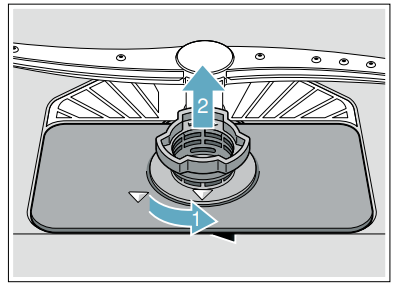
Remove the microfilter from the fine filter for easier cleaning.
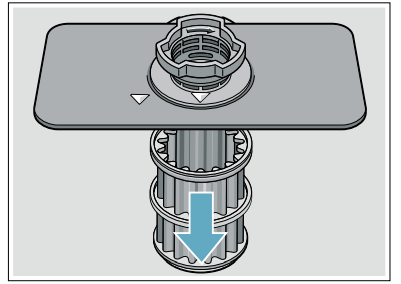
- Rinse the filters under running water and use a soft brush to clean.
Note: do not use abrasive brushes or steel wool, etc., as they may damage the filter. - Reinstall the filter system in reverse sequence and lock into place by screwing the Large Object Trap until the marking arrows align.
Spray arms
Check spray arms 23 and 26 for grease and limescale deposits.
If you find such deposits:
- Fill detergent dispenser 32 with detergent and start the appliance without utensils in the cycle with the highest rinsing temperature.
- Clean the appliance with detergents/appliance cleaners which are particularly suitable for use with dishwashers.
Unscrew the upper spray arm 23 and pull off the lower spray 26 arm as shown. Inspect for deposits.

Drain pump
Large food remnants in the rinsing water not retained by the filters may block the waste water pump.
In this case:
- Disconnect the appliance from the power supply.
- Remove the filters.
- Scoop out standing water - use a sponge if necessary.
Using a spoon, pry off the pump cover until it clicks, then grip the cover and pull upward until it resists and then pull forward.
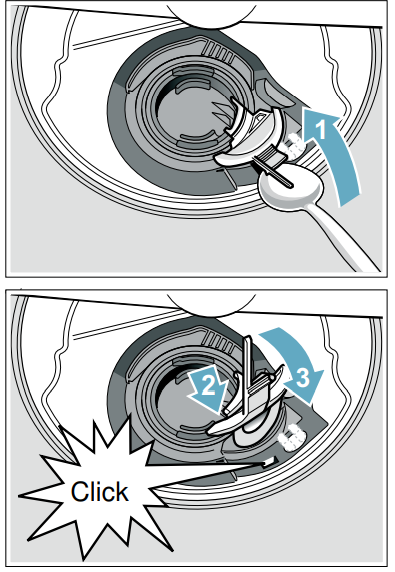
- Check inner compartment and remove any foreign objects.
WARNING: Use caution when removing parts for cleaning as some debris may be sharp. - Place cover in the original position, press down and engage.
- Reinstall filters.
Note: The drain pump will not work properly if the drain pump cover is not snapped in completely until it clicks.
Preparing your unit for vacation
NOTICE: Before leaving for vacation during warmer weather, besides turning off the main valve, also turn off water supply at the nearest point to the dishwasher. Do not leave soiled dishware in unit and leave door slightly open. During colder weather, please follow the instructions for winterizing your unit below.
Winterizing your unit
NOTICE: If your dishwasher will be unused for a period of time in a location that experiences freezing temperatures (holiday home or through a vacation period), have your dishwasher winterized by a professional service.
Troubleshooting of Bosch Dishwasher Lave-vaiselle SHX3AR
Dishwashers may occasionally exhibit problems that are unrelated to a malfunction of the dishwasher itself.
The following information may help you with a dishwasher problem without involving a repair professional.
| Problem | Cause | Action |
Error code “:‚‰ is lit. | Supply hose kinked. | Install supply hose without kinks. |
| Water supply turned off. | Turn on the water supply. | |
| Water supply line is clogged. | Unclog water line. | |
Error code “:ƒƒ is lit. | Water in sump since sump filters 1b are dirty or blocked. | Clean filters. |
Error code “:ƒ… is lit. | Drain line is clogged. | Unclog drain line. |
| Drain hose is kinked, clogged or blocked. | Replace drain hose. | |
| Drain pump impeller (vanes) is clogged or blocked. | Remove drain pump cover, clean around pump impeller and replace cover. | |
| Drain pump cover was loose. | Lock drain pump cover into place in the sump. | |
Error code “:ƒ† is lit. | Drain pump is blocked or pump cover is loose. | Clean drain pump and lock drain pump cover into place in the sump. |
Error code “:ƒˆ is lit. | Supply voltage too low (less than 98 volts). | Not a dishwasher fault; have the supply voltage and electrical installation checked. |
A different error code is indicated on the digital display. (“:‹‚ to “:„‹) | A technical fault has probably occurred. | Switch off dishwasher with the On/Off switch (. After a short time restart the dishwasher. If the problem recurs, turn off the tap and pull out the power supply plug. Call customer service and mention the error code. |
| Dishwasher does not start. | Door may be ajar or not be properly latched. | Close door securely until door latch clicks. |
| No power to the dishwasher (display won’t come on). Fuse may have been blown, circuit breaker may have tripped, power cord may have been unplugged or dishwasher may have been turned off. | Replace blown fuse or reset tripped circuit breaker. Plug power cord into outlet securely. Press the on/off button ( to turn the dishwasher on. | |
| Can’t select a wash cycle since the previous wash cycle may not have finished or the dishwasher hasn’t been reset. | Reset the dishwasher by pressing and holding the START button for at least three seconds. | |
| Delay start or Child lock may be activated. | Reset Delay start or Child lock functions (refer to the appropriate section in this manual). | |
| The door may have been closed without selecting a wash cycle. | Select a wash cycle and close the door. | |
| Water supply may not be turned on or connected. | Check and turn on water supply. | |
| Wash cycle won’t resume after door was opened and closed. | The door has been open for more than 4 seconds after pressing the Start button. | Press Start button again and close the dishwasher door within 4 seconds (see “Protection against unintentional operation” section in this manual). |
| Display does not illuminate. | A fuse may have been blown or circuit breaker tripped. | Check the fuse or circuit breaker box and replace the fuse or reset the breaker if necessary. |
Door not closed or latched. Note: For models with controls on top of the door, the display only illuminates when the door is opened and controls are visible. | Ensure door is properly latched and completely closed. |
| Dishwasher runs a long time. | Incoming water is not warm enough. | Before starting a cycle, run hot water faucet at the sink closest to the dishwasher. |
| Cycle time depends on wash cycle chosen and amount of soil on dishes (dishwasher sensors increase cycle times to ensure dishes are clean when heavy soil is detected). | Scrape food off of dishes and use less intensive wash cycles. | |
| Rinse aid dispenser 9* is empty, or rinse aid setting = 0. Without rinse aid, wash cycle defaults to longest time with most number of washes and rinses. | Add rinse aid and change rinse aid setting depending on water hardness. | |
| Dishwasher is connected to cold water supply. | Connect dishwasher to hot water supply. | |
| Dishes aren’t clean enough | Spray arms are blocked or misaligned where they cannot rotate freely. | Make sure spray arms 1:, 1R can rotate freely. |
| Little or no water spray due to clogged spray arm nozzle. | Clean out spray arm nozzles and filters of all debris and obstructions. ~ "Spray arms" on page 36 | |
| Little or no water spray due to clogged or misaligned filters 1b. | Clean filters and make sure they’re installed correctly. ~ "Filter components" on page 35 | |
| Dishes are nested or placed too closely together and racks are overfilled. | Space dishes apart so spray jets can reach the surface of the dishes and dishes don’t contact each other. ~ "Loading the Dishwasher" on page 15 | |
| Improper or ineffective wash cycle or detergent used. | Choose a more intensive wash cycle and use appropriate dishwasher detergents. ~ "Wash Cycle Information" on page 29 | |
| Detergent is made less effective due to hard water. | Install a water softener and choose a more intensive wash cycle. | |
| Removable spots or streaks on glasses and silverware. | Too much rinse aid causes streaks and too little rinse aid can cause spots. | Add rinse aid and check rinse aid setting (recommended setting 4-5). ~ "Rinse Aid" on page 13 |
| Mineral deposits from hard water. | Install a water softener. | |
| Water from top (3rd) or upper rack dripped on racks below. | Unload lower rack 1st, upper rack 2nd and top (3rd) rack last. |
| Dishes not dry. | Rinse aid dispenser 9* is empty or incorrect rinse aid amount is set. | Add rinse aid or adjust setting - the use of rinse agent improves drying, use the Auto cycle, use the Sanitize option. |
| Extra Dry heat option not chosen.* | Activate Extra Dry heat option.* | |
| Water collected in depressions on the dishes and silverware. | Arrange dishes in upper rack to slope so water can drain. | |
| Door was opened or dishes removed before wash cycle was completed. | Wait until wash cycle ends before opening door or removing dishes. | |
| Plastics don’t absorb heat like cutlery or china and don’t dry as well. | Use more intensive wash cycles (with hotter rinse water) or activate Extra Dry heat option.* | |
| Silverware not arranged properly in the silverware basket or top rack. | Arrange silverware properly and separate them so they don’t contact each other. | |
Odor Note: Water testing is done in the factory. Occasionally water may still appear in dishwasher at purchase which may create an odor. | Food debris in the dishwasher sump and door seal. | Clean sump filters, sump and door seal as needed. ~ "Care and Maintenance" on page 34 |
| Food debris left on dishes too long. | Run dishwasher more frequently. | |
| Not using rinse aid or using improper detergent. | Use rinse aid and the proper detergent. | |
| Residual standing water in the sump. | Make sure previous wash cycle has finished. | |
| Drain line is clogged or drain hose is kinked, clogged or blocked. Or drain hose was not installed with a high loop. | Unclog drain line or replace drain hose. Be sure drain hose is installed with high-loop. Note: If odor still persists, run the Normal/ Regular cycle until it flushes and interrupt the cycle and place an 8 oz. cup of distilled white vinegar solution on the upper rack and then finish the cycle. | |
| Dishwasher isn’t filling with water (or “Check water supply” display occurs) | Water supply hose is kinked. | Install new supply hose (without kinks). |
| Previous wash cycle was not completed or current wash cycle was interrupted. | Complete wash cycle or reset dishwasher. | |
| Delay start or Child lock may be activated. | Reset Delay start or Child lock functions (refer to the appropriate sections in this manual). | |
| Water supply line is clogged. | Unclog water line. | |
| Water supply was turned off. | Turn on water supply. | |
| Fascia panel is discolored or scratched. | Panel was cleaned with bleach-based wipes or abrasive cleaners/cleaning pads. | Use mild detergents with soft damp cloth. |
| Noise from dishes rattling or water striking tub walls. | Dishes weren’t loaded properly, allowing dishes to hit each other or spray arms. | Load dishes properly into racks. ~ "Loading the Dishwasher" on page 15 |
| Light dishes or lightly loaded racks allow dishes to move or water sprays to strike tubs. | Load more dishes or distribute dishes more evenly/securely in the dishwasher. | |
| Water leaks from tub or from around door. | Suds from using the wrong detergent (i.e. dish) or overfilling/spilling rinse aid. | Use an appropriate dishwasher detergent, don’t overfill rinse aid and clean any spilled rinse aid. If suds still persist, add one tablespoon of vegetable oil and run the desired cycle. |
| Door seal was misaligned or pulled from its track. | Make sure the door seal is securely inserted into its track. | |
| Condensation vent is blocked. | Clean out vent and move tall items like trays away from the vent. | |
| Improper installation. | Have an authorized service professional remount the dishwasher. | |
| White limescale on dishes, tub, racks or door. | White residue coats dishwasher interior and racks wheels squeak from lime scale deposits in hard water. | Use a dishwasher cleaner every few months. If dishwasher has a water softener, increase the setting. |
| Hard water kept 3 in 1 detergent or Eco detergent from being effective. | Use separate dishwasher detergent, rinse aid and dishwasher softener salt (if dishwasher has a softener). | |
| Under dosing of detergent. | Use more detergent or change to a more effective detergent. | |
| Rinse temperature is too low. | Select more intensive wash cycles with higher washing temperatures. | |
| Detergent dispenser cover will not shut | Cover guides are blocked by sticky detergent residue. | Remove detergent residue.~ "Detergent" on page 25 |
| Unable to select desired cycle | Previous cycle not finished. | ~ "Operating the Dishwasher" on page 30 |
Warranty
How Long the Warranty Lasts
Bosch warrants that the Product is free from defects in materials and workmanship for a period of three hundred sixty-five (365) days from the date of the original purchase. The foregoing timeline begins to run upon the date of the original purchase, and shall not be stalled, tolled, extended, or suspended, for any reason whatsoever.
Product, for a period of thirty (30) days from the date of purchase or closing date for new construction. This cosmetic warranty excludes slight color variations due to inherent differences in painted and porcelain parts, as well as differences caused by kitchen lighting, product location, or other similar factors.
Bosch Dishwasher Lave-vaiselle SHX3AR Pros & Cons
Pros
- Energy-efficient and eco-friendly design.
- Advanced CrystalDry technology for superior drying performance.
- Quiet operation with a noise level of 39 dBA.
- Multiple wash cycles including sanitize cycle.
- Third rack for additional storage space.
- Stainless steel tub for durability.
Cons
- Higher upfront cost compared to some competitors.
- Zeolite minerals in CrystalDry feature may need periodic replacement.
- Slightly longer cycle times due to advanced cleaning technology.
- Some users may find the user interface less intuitive compared to other models.
Customer Reviews
Customers generally praise the Bosch SHX3AR for its excellent cleaning performance, quiet operation, and energy efficiency. However, some users have noted that the initial setup can be complex and that replacement parts for the CrystalDry feature may be expensive. Here are some common complaints:
- Complex setup process.
- Higher cost of replacement parts for CrystalDry feature.
Faqs
How do I replace the zeolite minerals in the CrystalDry feature?
Why is my Bosch Dishwasher Lave-vaiselle dishwasher making noise during operation?
Can I use any detergent with my Bosch Dishwasher?
How do I troubleshoot error codes on my Bosch?
Is the Bosch compatible with smart home systems?
What is the energy consumption of the Boschdishwasher?
How often should I clean the filters of my Bosch Lave-vaiselle SHX3AR?
Can I install the Bosch myself?
How long does a typical wash cycle take on the Bosch?
Is there a warranty on the Bosch Dishwasher?
How do I level my Lave-vaiselle during installation?
Leave a Comment
